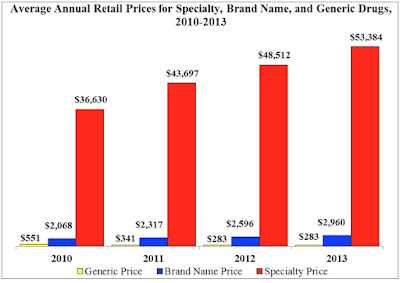In the United States, both parties are promising fresh action on drug prices whoever wins the White House. In Europe, economies are stalled, squeezing state health budgets. And in China and other Asian markets, governments are getting tougher with suppliers.
 |
| Source: AARP Annual Rx Price Trends Report |
Pricing drugs based on clinical outcomes is one way to ensure that limited funds bring the most benefits to patients now and pay for the most promising medical advances in future. Some experiments in pricing have already been made. But shifting the overall industry to a new model requires improvements in data collection and a change in thinking, say drug pricing experts.
“Eventually, we are going to get there,” said Kurt Kessler, managing principal at ZS Associates in Zurich, which advises companies on sales and marketing strategies. “But it is a long, tough slog because it’s difficult to get the right data and agree on what the right outcomes are to measure.”
In the past, governments and insurers made room in their budgets for new drugs by switching to cheap generics as patents expired on older drugs. But today generics already account for nearly nine out of every 10 prescriptions in key markets like the United States, and fewer big drugs are going off patent.
That leaves little headroom for pricey new medicines for cancer and other hard-to-treat diseases, even as they come to market in growing numbers. The U.S. Food and Drug Administration has already approved 16 new drugs this year.
Investors got a wake-up call on the issue last Friday when $10 billion was lopped off the market value of Novo Nordisk as the world’s biggest diabetes firm warned of falling U.S. prices.
Pharmacy benefit managers administering U.S. health plans are pushing back hard by excluding some drugs deemed too expensive – including Novo’s – leading to a crunch in areas like diabetes, a disease that now accounts for 12 percent of global healthcare spending.
The Danish group has an unusually high exposure to the U.S. market, but it is not alone in signalling tough times ahead. The chief executives of Novartis, Eli Lilly and GlaxoSmithKline have all warned recently that pricing will become increasingly challenging across the board.
Accounting for 40 percent of global drug sales, the fate of the U.S. market is front and centre in the minds of drug company executives, some of whom privately admit to preparing for a “confrontational” period in relations with politicians.
Read more: Future of Drug Pricing: Paying for Benefits?
